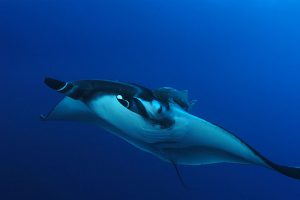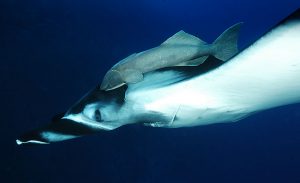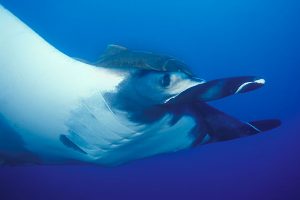
Manta Rays: The Ocean’s Kings of Charisma
by Todos Santos Eco Adventures
This article was first published in Janice Kinne’s Journal del Pacifico.
Marine mammals know how to get the love. Fish, not so much. You post a picture of a sea lion or a dolphin on Facebook, and you’re likely to get comments about cuteness, playfulness, intelligence – the emotion you feel when it looks you in the eye. You post a picture of a sea bass or a dorado on Facebook, and you’re likely to get comments about dinner, seasoning, grilling techniques – apparently fish giving us the fisheye doesn’t tug at our heartstrings.

Manta Ray Eye Photo by Kaia Thomson
But there is one fish that no less an authority on charisma than businessman Richard Branson calls “one of the most charismatic creatures in the ocean”, and that is the elegant, enormous, manta ray. With the largest brain-to-body ratio of all elasmobranchs*, the manta ray is one of the most intelligent fish in the sea. Making that brain function well is a system of blood vessels that envelope the manta’s braincase, keeping the brain warmer than the surrounding tissue. A big, warm brain fosters intelligence, intelligence fosters curiosity, and curiosity causes manta rays to interact with human beings in the water. It’s an incredible thrill.
Manta rays are magnificent creatures to behold. It’s not just that they’re huge: they typically reach a width of 22 feet (7 meters) and a weight of over 3,000 pounds (1,400 kg); and it’s not just that they’re prehistoric-looking: they have cephalic fins on either side of their heads to direct food, which look like horns when furled; it’s just that they’re so darn cool: they look like stealth bombers in the sea, yet move that remarkable bulk with utter grace, using their massive triangular wings (pectoral fins) to fly through the sea, exuding the glide and flow of an eagle in flight. So when you realize that this fish that seems straight out of myth is turning in patterns with you, engaging with you, and – like any good dance partner – making direct (fish) eye contact with you, it, well, tugs at your heartstrings.

Manta Ray Coming to Visit Photo by Kaia Thomson
But some people still just see dinner. Despite the fact that fishing for oceanic manta rays was banned in Mexico in 2007, and that the possession and trade of all mantas and mobulids in Mexican waters is prohibited by law, you can walk into local markets in many Baja towns and find stacks of dried and salted rays for sale. They’re considered an excellent, affordable source of protein. On a global scale the problem is more menacing. Across the tropics they inhabit, mantas are now being killed for their gill rakers, the cleansing plates that filter their food from the ocean. Manta and mobula gill rakers are the latest snake oil cure-all in China, touted as a remedy that cleanses the body of everything from gout to cancer. The organization Manta Ray of Hope, which is acting to protect manta rays from this trade, estimates that the annual gill raker trade volume is 61,000 to 80,000 kilograms (135,000 to 176,000 pounds), with an estimated value of US$11.3 million.
But businessman Richard Branson, who is campaigning for manta ray protection, points out that “while the gills are valuable, the trade is also robbing local economies of [the mantas], which could draw millions of dollars each year for those communities.” In fact, Manta Ray of Hope estimates that manta and mobula ray tourism has an estimated annual value of over US$100 million per year, a far more compelling number than the $11 million currently enjoyed by the gill raker trade. If enough awareness is raised and policy makers (and policy enforcers) act quickly enough, there is still time to staunch what many fear could otherwise be the depletion of the global manta ray population.

Manta Ray Photo by Kaia Thomson
And in Baja California Sur we know the pure joy of having the mantas and mobulas as neighbors. Many days from the Pacific beach it is possible to see the mobula rays skipping along the water, making that distinctive flap-flap-flapping sound as they soar through the air and hit the water repeatedly. And in the Sea of Cortez we’re starting to see a return of the giant manta rays, with a large number of sightings over the last several months. So if you’re in Baja, take the time out to go engage with these remarkable creatures in their natural habitat, and let their charm work itself on you. Once you get to know them, you’ll definitely be joining Richard Branson in giving the gill raker traders the old fisheye.
*Elasmobranchs are in the Class Elasmobranchii, which covers cartilaginous fishes such as sharks, rays and skates.
Manta Ray Fun Facts:
- Manta is the Spanish word for blanket, an apt description of the manta ray shape
- Like their shark cousins, the manta’s skin is covered with dermal denticals – sort of modified teeth that are covered with hard enamel. These are packed tightly together with the tips facing backwards. Not only do they help in protecting the animals from predators, they also aid in hydrodynamics. Manta skin is also covered in a type of mucus which helps protect it from parasites and infection.
- Manta rays have terminal mouths strategically located at the front of their heads for filtering the large quantities of water they take in as their gill rakers filter out the plankton they feed on (mantas eat about 13% of their body weight each week). Mobula rays have sub-terminal mouths, located underneath the head. While mantas do have teeth, they’re generally nonfunctional – a common occurrence among filter feeders.
- Mantas are relatively long-lived – up to 40+ years.
- Mantas, like other sharks, visit oceanic “cleaning stations” where they cease all movement and open their mouths and gills wide to allow in cleaner fish like wrasses and gobies who happily consume any nutritious parasites that may be present. Mantas repay the favor by not eating the cleaner fish.
- Mantas reproduce via ovoviviparity, i.e., the young hatch from eggs inside the female’s body and the pups are nourished by yolk instead of placenta.
- Female mantas give birth to only one or two pups every two to five years, and will have a maximum of 16 pups over a lifetime. By comparison, a great white shark produces a maximum of 14 pups in just one litter. This combination of long life and infrequent reproduction increase the manta’s vulnerability.
- Manta rays were practically wiped out of the Sea of Cortez due to targeted species fishing in the 1980s and 1990s, but have been making a comeback under federal protection since 2007. It is now possible once again to see, swim and engage with the mantas in the Sea of Cortez. It’s a remarkable life experience.
